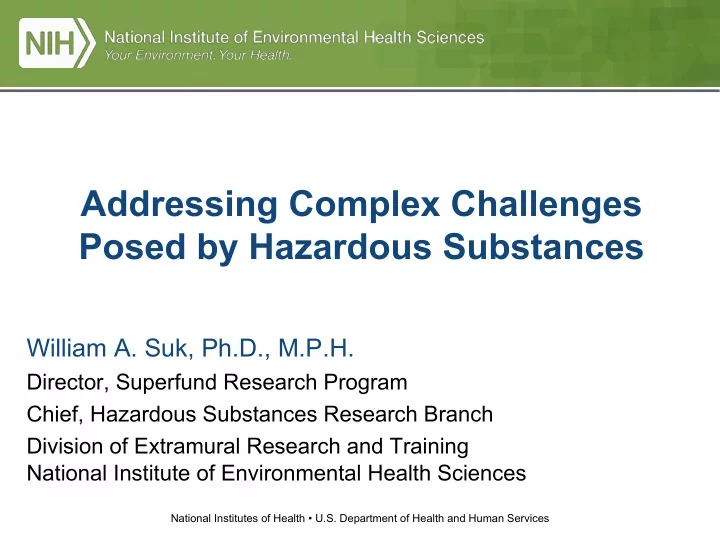

Addressing Complex Challenges Posed by Hazardous Substances William A. Suk, Ph.D., M.P.H. Director, Superfund Research Program Chief, Hazardous Substances Research Branch Division of Extramural Research and Training National Institute of Environmental Health Sciences National Institutes of Health • U.S. Department of Health and Human Services
Primary Objectives - SRP Mandates Supported by the National Institute of Environmental Health Sciences, the Superfund Research Program (SRP) funds research related to the development of: Advanced techniques for Methods and the detection, technologies to detect assessment, and hazardous substances in evaluation of the effects the environment on human health of hazardous substances Basic biological, Methods to assess the chemical, and physical risks to human health methods to reduce the presented by hazardous amount and toxicity of substances hazardous substances National Institutes of Health U.S. Department of Health and Human Services
Multidisciplinary research addressing broad, complex issues related to hazardous substance exposure Fate and Epidemiology Transport Health Remediation Effects Unifying Theme Mechanistic Ecology Toxicology Studies Community Research Training Training Engagement Translation
SRP Research Exposure and Health Effects Tools to evaluate exposure Tools to assess health effects Chemical safety evaluation
SRP Research: New Approaches and Alternatives for Toxicity, Fate and Transport, and Ecotoxicity Testing National Institutes of Health • U.S. Department of Health and Human Services
Zebrafish: health effects of developmental exposures • Combined panel of zebrafish genes with a rapid testing platform to identify chemicals that induce oxidative stress (University of Washington) • Found that PBDEs can bind to proteins that regulate thyroid hormones and bone development using zebrafish (Duke University) • Zebrafish model to define the toxicity of complex PAH mixtures (Oregon State Learn more from Lisa Truong University) in Session I of this series
New tools for studying ecotoxicology • Explored the complex genetics involved in how Atlantic killifish have rapidly evolved to tolerate polluted East Coast estuaries (Boston University) • Examined mechanisms of olfactory injury and oxidative stress in salmon (University of Washington) • Developed a 3D liver cell model to screen chemicals for toxicity in fish (Brown University) Learn more from April Rodd in Session I of this series
Screening for hazardous chemicals in the environment and in human samples • Cell-based assays combined with imaging and web-based analysis to quickly assess the risks of endocrine disrupting chemicals during environmental emergencies. (Texas A&M) • Immunoassays using VHH antibodies isolated from alpacas to detect PCBs, pesticides, and other compounds and degradation products. (UC Davis)
New approaches to understand fate and transport • Developing models to predict vapor concentrations seeping into buildings (Brown University and University of Kentucky) • Assessing pathways that transport PAHs in the atmosphere using spatial and temporal tracking (Massachusetts Institute of Technology) • Using novel statistical methods to fingerprint PFAS measured in fish and drinking water (University of Rhode Island) • Identifying how asbestos forms aggregates and moves through groundwater (University of Pennsylvania)
Computational methods to predict the toxicity and exposure • Computational pipeline to construct chemical networks (Boston University) • A novel platform that can rapidly and automatically analyze environmental samples to screen for chemicals (Texas A&M) Learn more from Erin Baker in Session II of this series
Computational methods to predict the toxicity • Platform to map the reactivity of environmental chemicals (UC Berkeley) • A computational approach using cell-based data to estimate differences in susceptibility to chemicals based on population variability (Texas A&M) You will hear more from Weihsueh Chiu
Developing models to integrate diverse data sets in in vitro vivo in silico Chemical safety evaluation
Enhancing environmental health solutions through data integration Biological response data Reducing Exposure Epidemiology Enhance the data data the burden knowledge of disease base Sustainable Fate and remediation transport data data National Institutes of Health U.S. Department of Health and Human Services
Past SRP Risk e-Learning Webinars • Archives are available from related SRP Risk e-Learning webinars • Fall 2017: Adverse Outcome Pathways – Introduction to the Adverse Outcome Pathway Framework – Assembling and Assessing AOP Information • Spring 2017: Analytical Tools and Methods – Field-Ready Biosensors to Assess Bioavailability and Toxicity – Techniques for Trace Analysis of Metals and Chemical Mixtures – Fate and Transport of Contaminants • Current series: New Approaches and Alternatives for Toxicity Testing National Institutes of Health U.S. Department of Health and Human Services
Recommend
More recommend